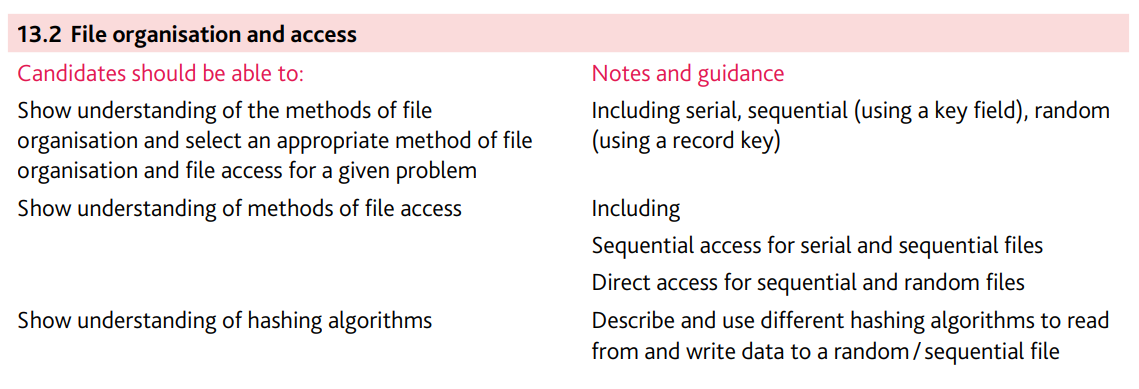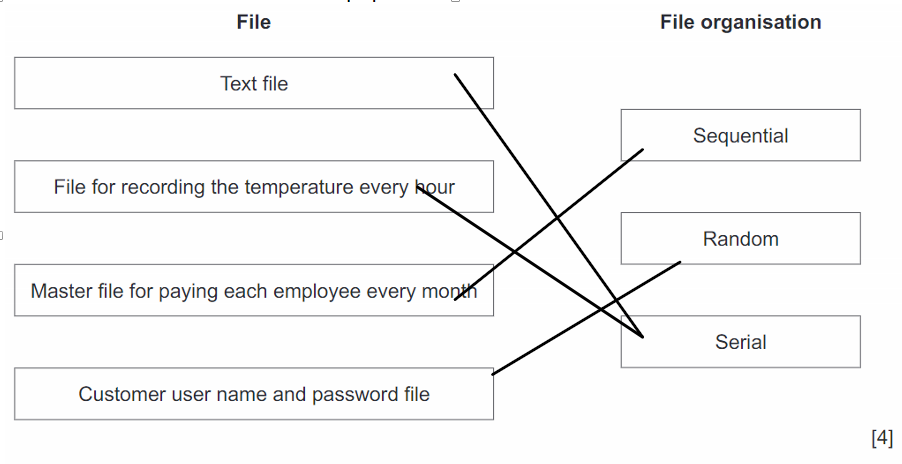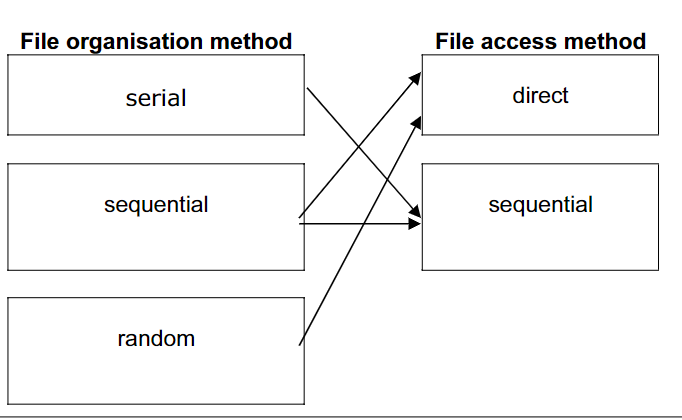Chapter 13.2: File organisation and access

File organisation
Serial file organisation
Method of file organisation in which records of data are physically stored in a file, one after another, in the order they were added to the file
New records are appended to the end of the file. Serial file organisation is often used for temporary files storing transactions to be made to more permanent files. e.g. storing customer meter reading for gas/electricity before they are used to send the bills to all customers.
- Each transaction is added to the file in the order of arrival
- These records will be in chronological order
- High hit rate
- Suitable for batch processing
- Order not important
- The records will be accessed one after another[^1]
[^1]: Sequential file access
Sequential file organisation
Method of file organisation in which records of data are physically stored in a file, one after another, in a given order
Physically stores records of data in a file, one after another, in a given order. The order is usually based on the key field of the records as this is the unique identifier.
- High hit rate
- Suitable for batch processing of records
- File organised using unique ID called key field
The difference between key fields in a file and primary keys in a database table. In the database table the primary key values must all be unique. This is not a requirement for key fields in any type of file. It may be sensible in certain applications to ensure key fields have unique values, but it is not mandatory.
Random file organisation
Method of file organisation in which records of data are physically stored in a file in any available position, the position of any record in a field is found by applying a hash algorithm on the key field of the record/record key.
- Records can be added to any empty position
- Key field is hashed to produce the home location
- If home location is free, insert the data
- Else, use overflow method to find free location to store the data
- If no free location is available, the file is full and data cannot be added/stored
--- Real-time processing
- Fast access to data
- No need to search through records
Past-paper Questions:
- Compare Serial and Sequential file organisation:
- In both serial and sequential organisation, Records are added to the file one after another
- ... and they needs to be accessed one after another
- For serial file organisation, records are added in a chronological order
- For sequential file organisation, records are stored with a given order
- … in the order of the key field
- For serial file organisation, records are added in the next available space // records are appended to the file
- For sequential file organisation, records are inserted into the correct position
2.

3.

4.
The programmer decides to store all the data in a file. Initially, data from 27 locations will be stored. More rainfall locations will be added over time and will never exceeds 100. The programmer has to choose between two types of file organisation: serial and sequential.
Give two reasons for choosing Serial file organisation:
- No need to re-sort data every time new data is added
- Only a small file so searching would require little processing
- New records can be easily added
File access
Method used to physically find a record in a file
Sequential access
A method of file access in which records are searched one after another from the physical start of the file until the required record is found, or a new record can be added to the file. This method is used for
serialandsequentialfiles.
- High hit rate
For a serial file, if a particular record is being searched for, every record needs to be checked until the record is found or the whole file has been searched and that record has not been found. Any new records are appended to the end of the file.
For a sequentialfile, if a particular records is being searched for, every records needs to be checked until the record is found or the key filed of the current record being checked is greater than the key field of the record being searched for. The rest of the file does not need to be searched as the records are sorted on ascending key field values.
Sequential access if efficient when every record in the file needs to be processed. e.g. a monthly billing or payroll system.
Direct access
A method of file access in which a record can be physically found in a file without reading other records.
- Both
sequentialandrandomfiles can use direct access. - Allow specific records to be found more quickly than using sequential access.
- Low hit rate
Direct access is required when an individual record from a file needs to be processed. e.g. when a single customer record needs to be updated when the customer’s phone number is changed.
For a sequential file, an index of all the key fields is kept and used to look up the address of the file location where a given record is stored. For large files, searching the index takes less time than searching the whole file.
A separate index file is created which has two fields per record. The first record has the key field value and the second filed has a value for the position of this key field value in the main file.
For a random access file, a hashing algorithm is used on the key filed to calculate the address of the file location where a given record is stored.
Hashing algorithms
A mathematical formula used to perform a calculation on the
record key. The result of the calculation gives the address where the record should be found. More complex hashing algorithms are used in the encryption of data.
Two ways of dealing with collision:
open hash: the record is stored in the next free space.
close hash: an overflow area is set up and the record is stored in the next free space in the overflow area.
Past-paper questions
1 | FUNCTION hash(BookingID: INTEGER) RETURNS INTEGER |
